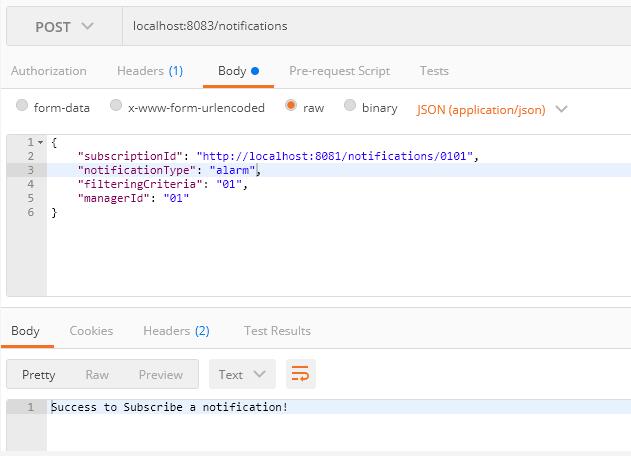- ubuntu12.04环境下使用kvm ioctl接口实现最简单的虚拟机
- Ubuntu 通过无线网络安装Ubuntu Server启动系统后连接无线网络的方法
- 在Ubuntu上搭建网桥的方法
- ubuntu 虚拟机上网方式及相关配置详解
CFSDN坚持开源创造价值,我们致力于搭建一个资源共享平台,让每一个IT人在这里找到属于你的精彩世界.
这篇CFSDN的博客文章SpringBoot通知机制的实现方式由作者收集整理,如果你对这篇文章有兴趣,记得点赞哟.
Spring Boot版本1.3.6以及一些工程基本信息点击“Switch to the full version.”java版本选择1.7; 。
使用eclipse,Import -> Existing Maven Projects -> Next ->选择解压后的文件夹-> Finsh,OK done.
使用IDEA的话,按如下步骤导入项目: File -> New -> Project fron Existing Sourses -> 选择解压后的直接包含pom.xml文件的demo文件夹,OK -> 选第二项Import project from external model, 选maven,Next -> Next -> 勾选左下角Open Project Structure after import, Next -> Next -> Finish -> 选Yes -> OK -> 大功告成! 。
(记录自己踩过的坑:一定要选直接包含pom.xml的demo文件夹,一开始选择直接解压后的demo文件夹,结果找不到可以导入的maven项目。 ) 。

访问localhost:8080/hello, 看到页面显示Hello World.
订阅信息包括通知类型(notificationTypes)、过滤条件(filteringCriteria)、订阅者地址(subscriberUri)和 managerId.
请求数据以json格式发送,因此在服务端用@RequestBody Map request 来处理请求中的json数据,创建JSONObject 对象,从而根据参数名获取请求中传入的参数值.
服务端代码如下:
@RequestMapping("/notifications") public void subscribeNotification(@RequestBody Map request, HttpServletResponse response) throws ServletException, IOException, JSONException { System.out.println("Enter localhost:8083/notifications. " ); JSONObject jsonObject = new JSONObject(request); String subscriptionId = (String) jsonObject.get("subscriptionId"); // 通过JSONObject 对象获取请求中传入的参数值 String notificationType = (String) jsonObject.get("notificationType"); String filteringCriteria = (String) jsonObject.get("filteringCriteria"); String managerId = (String) jsonObject.get("managerId"); System.out.println("subscriptionId=" + subscriptionId + ", notificationType=" + notificationType + ", filteringCriteria=" + filteringCriteria + ", managerId=" + managerId ); // some code... 省略了存数据库的操作 response.setHeader("Location", "http://localhost:8083/notifications/0101"); // 通过response.setHeader()方法设置响应头 PrintWriter out = response.getWriter(); String result = "Success to Subscribe a notification! "; out.write(result); }
服务端端口设为8083,默认是8080,可以通过在resources 下的application.properties文件里加一条语句server.port=8083 修改为其他端口号.
Postman的接口测试结果如下:

请求信息包括订阅Id(subscriptionId)、通知类型(NotificationType)、发送者Id(producerId)、消息(message)。首先根据subscriptionId 从数据库查找到该订阅的通知类型、过滤条件和订阅者地址,然后判断该通知是否符合订阅条件,符合则将该通知发送给订阅者.
服务端代码如下:
@RequestMapping("/sendNotification") public void sendNotification(@RequestBody Map request, HttpServletResponse response) throws ServletException, IOException, JSONException { System.out.println("request:" + request); JSONObject jsonObject = new JSONObject(request); System.out.println("jsonObject:" + jsonObject); String subscriptionId = (String) jsonObject.get("subscriptionId"); String notificationType = (String) jsonObject.get("notificationType"); String producerId = (String) jsonObject.get("producerId"); String alarmType = (String) jsonObject.getJSONObject("message").get("alarmType"); System.out.println("subscriptionId=" + subscriptionId + ", notificationType=" + notificationType + ", producerId=" + producerId + ", alarmType=" + alarmType ); // some code... 查询数据库(省略) // 模拟数据库查询结果 String getNotificationType = ""; String getAlarmType = ""; String getsubscriberUri = ""; if(subscriptionId.equals("http://localhost:8081/notifications/0101")){ getNotificationType = "alarm"; getAlarmType = "01"; getsubscriberUri = "http://localhost:8081/notifications/001"; } if(subscriptionId.equals("http://localhost:8081/notifications/0102")){ getNotificationType = "alarm"; getAlarmType = "02"; getsubscriberUri = "http://localhost:8082/notifications/001"; } // 判断该通知是否符合订阅条件 String subscribeURL = ""; if(notificationType.equals(getNotificationType) && alarmType.equals(getAlarmType)){ subscribeURL = getsubscriberUri; } else return; // 建立连接,将通知发送给订阅者 HttpURLConnection subscribeConnection = null; StringBuffer responseBuffer = new StringBuffer(); try{ URL getsubscribeURL = new URL(subscribeURL); subscribeConnection = (HttpURLConnection) getsubscribeURL.openConnection(); // 建立连接 subscribeConnection.setDoOutput(true); subscribeConnection.setDoInput(true); subscribeConnection.setRequestMethod("POST"); subscribeConnection.setRequestProperty("Accept-Charset", "utf-8"); subscribeConnection.setRequestProperty("Content-Type", "application/json"); subscribeConnection.setRequestProperty("Charset", "UTF-8"); byte[] data = (jsonObject.toString()).getBytes(); subscribeConnection.setRequestProperty("Content-Length", String.valueOf(data.length)); // 开始连接请求 subscribeConnection.connect(); OutputStream out = subscribeConnection.getOutputStream(); // 写入请求的字符串 out.write((jsonObject.toString()).getBytes()); // 发送json数据 out.flush(); out.close(); }catch (IOException e) { } if (subscribeConnection.getResponseCode() == 200) { // 若响应码为200,则通知订阅成功 System.out.println("Success to send the notification." ); String readLine; BufferedReader responseReader = new BufferedReader(new InputStreamReader( subscribeConnection.getInputStream(), "utf-8")); while ((readLine = responseReader.readLine()) != null) { responseBuffer.append(readLine); } System.out.println("Http Response:" + responseBuffer); subscribeConnection.disconnect(); PrintWriter out = response.getWriter(); out.write(responseBuffer.toString()); }else return; }
订阅者(8081端口)接收通知,代码如下:
@RequestMapping("/notifications/001") public void receiveNotification(@RequestBody Map request, HttpServletResponse response) throws ServletException, IOException{ System.out.println("Receive a new notification." ); System.out.println("request:" + request); PrintWriter out = response.getWriter(); String result = "Success to Subscribe a notification! "; out.write(result); }



附上demo源码地址: https://github.com/bupt-lxl/SpringBoot-Notification 。
以上为个人经验,希望能给大家一个参考,也希望大家多多支持我.
原文链接:https://blog.csdn.net/Bupt_Lili/article/details/80424894 。
最后此篇关于SpringBoot通知机制的实现方式的文章就讲到这里了,如果你想了解更多关于SpringBoot通知机制的实现方式的内容请搜索CFSDN的文章或继续浏览相关文章,希望大家以后支持我的博客! 。
广播的原则 如果两个数组的后缘维度(从末尾开始算起的维度)的轴长度相符或其中一方的长度为1,则认为它们是广播兼容的。广播会在缺失维度和(或)轴长度为1的维度上进行。 在上面的对arr每一列减去列
之前在讲 MySQL 事务隔离性提到过,对于写操作给读操作的影响这种情形下发生的脏读、不可重复读、虚读问题。是通过MVCC 机制来进行解决的,那么MVCC到底是如何实现的,其内部原理是怎样的呢?我们要
我创建了一个 JavaScript 对象来保存用户在 ColorBox 中检查复选框时设置的值。 . 我对 jQuery 和“以正确的方式”编程 JavaScript 比较陌生,希望确保以下用于捕获用
我为了回答aquestion posted here on SO而玩示例,发现很难理解python的import *破坏作用域的机制。 首先是一点上下文:这个问题不涉及实际问题;我很清楚from fo
我想让我的类具有标识此类的参数 ID。例如我想要这样的东西: class Car { public static virtual string ID{get{return "car";}} }
更新:我使用的是 Java 1.6.34,没有机会升级到 Java 7。 我有一个场景,我每分钟只能调用一个方法 80 次。它实际上是由第 3 方编写的服务 API,如果您多次调用它,它会“关闭”(忽
希望这对于那些使用 Javascript 的人来说是一个简单的答案...... 我有一个日志文件,该文件正在被一个脚本监视,该脚本将注销中的新行提供给任何连接的浏览器。一些人评论说,他们希望看到的更多
我们正在开发针对 5.2 开发的 PHP 应用程序,但我们最近迁移到了 PHP 5.3。我们没有时间去解决所有迁移到 PHP 5.3 的问题。具体来说,我们有很多消息: Declaration of
简介 在实现定时调度功能的时候,我们往往会借助于第三方类库来完成,比如: quartz 、 spring schedule 等等。jdk从1.3版本开始,就提供了基于 timer 的定时调度功能。
Java中,一切都是对象,在分布式环境中经常需要将Object从这一端网络或设备传递到另一端。这就需要有一种可以在两端传输数据的协议。Java序列化机制就是为了解决这个问题而
我将编写自己的自定义控件,它与 UIButton 有很大不同。由于差异太大,我决定从头开始编写。所以我所有的子类都是 UIControl。 当我的控件在内部被触摸时,我想以目标操作的方式触发一条消息。
在我的代码中,在创建 TIdIMAP4 连接之前,我设置了一大堆 SASL 机制,希望按照规定的“最好到最差”顺序,如下所示: IMAP.SASLMechanisms.Add.SASL := mIdS
在 Kubernetes 中,假设我们有 3 个 pod,它们物理上托管在节点 X、Y 和 Z 上。当我使用“kubectl expose”将它们公开为服务时,它们都是集群中的节点(除了 X、Y 和
关闭。这个问题需要多问focused 。目前不接受答案。 想要改进此问题吗?更新问题,使其仅关注一个问题 editing this post . 已关闭 9 年前。 Improve this ques
我知道进程间通信 (ipc) 有几种方法,例如: 文件 信号 socket 消息队列 管道 命名管道 信号量 共享内存 消息传递 内存映射文件 但是我无法找到将这些机制相互比较并指出它们在不同环境中的
当我尝试连接到 teradata 时,出现了TD2 机制不支持单点登录 错误。 在 C# 中,我遇到了类似的问题,我通过添加 connectionStringBuilder.Authetication
我有一个带有 JSON API 的简单 Javascript 应用程序。目前它在客户端运行,但我想将它从客户端移动到服务器。我习惯于学习新平台,但在这种情况下,我的时间非常有限 - 所以我需要找到绝对
我想了解事件绑定(bind)/解除绑定(bind)在浏览器中是如何工作的。具体来说,如果我删除一个已经绑定(bind)了事件的元素,例如使用 jQuery:$("#anElement").remove
我不是在寻找具体答案,只是一个想法或提示。我有以下问题: Android 应用程序是 Web 服务的客户端。它有一个线程,通过 http 协议(protocol)发送事件(带有请求 ID 的 XML
我正在研究 FreeBSD TCP/IP 栈。似乎有 2 种 syn flood 机制,syncookies 和 syncache。我的问题是关于 syncookies,它是从头开始还是在 SYN 队

我是一名优秀的程序员,十分优秀!